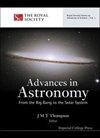Revisiting the Question: The Cause of the Solar Cycle Variation of Total Solar Irradiance
IF 1.2
4区 物理与天体物理
Q3 ASTRONOMY & ASTROPHYSICS
引用次数: 3
Abstract
The Mg II index and sunspot area are usually used to represent the intensification contribution by solar bright structures to total solar irradiance (TSI) and sunspot darkening, respectively. In order to understand the cause of the solar cycle variation of TSI, we use extension of wavelet transform, wavelet coherence (WTC), and partial wavelet coherence (PWC), to revisit this issue. The WTC of TSI with sunspot area shows that the two time series are very coherent on timescales of one solar cycle, but the PWC of TSI with sunspot area, which can find the results of WTC after eliminating the effect of the Mg II index, indicates that the solar cycle variation of TSI is not related to sunspots on the solar surface. The coherence of two time series at these timescales should be due to a particular phase relation between sunspots and TSI. The WTC and PWC of TSI with Mg II index show that the solar cycle variation of TSI is highly related to Mg II index, which reflects the relation of TSI with the long-term part of Mg II index that shows the intensification contribution by the small magnetic features to TSI. Consequently, the solar cycle variation of TSI is dominated by the small magnetic features on the solar full disk. Additionally, we also show the combined effects of the sunspot darkening and the intensification contribution represented by Mg II index to TSI on timescales of a few days to several months and indicate that the faculae increase TSI and contribute to its variation at these timescales.再谈问题:太阳总辐照度太阳周期变化的原因
Mg指数和太阳黑子面积通常分别代表太阳明亮结构对太阳总辐照度(TSI)和太阳黑子变暗的增强贡献。为了了解太阳周期TSI变化的原因,我们使用了小波变换的扩展、小波相干性(WTC)和部分小波相干性(PWC)来重新审视这一问题。与太阳黑子面积的TSI的WTC表明两个时间序列在一个太阳周期的时间尺度上非常一致,但与太阳黑子面积的TSI的PWC可以在消除Mg II指数的影响后找到WTC的结果,表明TSI的太阳周期变化与太阳表面的黑子无关。两个时间序列在这些时间尺度上的一致性应归因于太阳黑子与TSI之间的特殊相位关系。TSI与Mg II指数的WTC和PWC表明,TSI的太阳周期变化与Mg II指数高度相关,这反映了TSI与Mg II指数长期部分的关系,表明了小磁特征对TSI的强化贡献。因此,TSI的太阳周期变化是由太阳全盘上的小磁特征主导的。此外,在数天至数月的时间尺度上,我们还展示了太阳黑子变暗和Mg指数对TSI的强化贡献的综合效应,并表明在这些时间尺度上,光斑增加了TSI并促进了其变化。
本文章由计算机程序翻译,如有差异,请以英文原文为准。
求助全文
约1分钟内获得全文
求助全文
来源期刊

Advances in Astronomy
ASTRONOMY & ASTROPHYSICS-
CiteScore
2.70
自引率
7.10%
发文量
10
审稿时长
22 weeks
期刊介绍:
Advances in Astronomy publishes articles in all areas of astronomy, astrophysics, and cosmology. The journal accepts both observational and theoretical investigations into celestial objects and the wider universe, as well as the reports of new methods and instrumentation for their study.
 求助内容:
求助内容: 应助结果提醒方式:
应助结果提醒方式:


